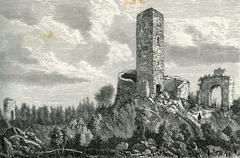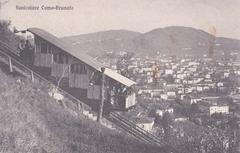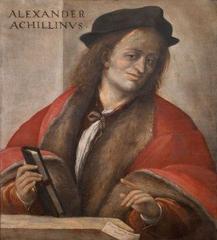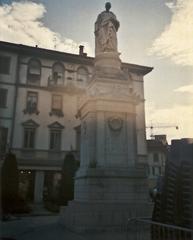
Basilica of Sant’Abbondio Como: Visiting Hours, Tickets, and Historical Significance
Date: 04/07/2025
Introduction
Nestled just beyond the ancient city walls of Como, Italy, the Basilica of Sant’Abbondio stands as an enduring symbol of the region’s spiritual and architectural legacy. With origins tracing back to the 5th century, this landmark offers visitors a remarkable journey through early Christian roots, medieval monastic culture, and the Romanesque artistry that defines much of Lombardy’s heritage. Its evolution—from a humble Palaeo-Christian church to a Benedictine monastic center and, ultimately, a Romanesque masterpiece—reflects centuries of religious, cultural, and artistic transformation. Today, the basilica remains a serene retreat for travelers seeking to immerse themselves in Como’s layered history and artistic treasures (Live the World, VisitComo, Explore Lake Como).
Table of Contents
- Historical Overview
- Architectural and Artistic Highlights
- Religious Role and Community Life
- Visitor Information
- Frequently Asked Questions (FAQ)
- Conclusion & Call to Action
- References
Historical Overview
Early Foundations: The Palaeo-Christian Era
The site of Sant’Abbondio has been sacred since the 5th century, when St. Amantius, the third bishop of Como, founded a church dedicated to Saints Peter and Paul. This early basilica, with a simple rectangular plan and timber roof, became a focal point for Christian worship outside the city walls. Relics from Rome, brought by St. Amantius, enhanced its spiritual significance (Live the World, Wikipedia).
Archaeological evidence of the ancient church can still be traced in the present basilica’s pavement, where black and pale marble stones mark the outline of the original structure, discovered during 19th-century restoration efforts (Live the World).
Transition to Episcopal Seat and Dedication
By the 9th century, the church was rededicated to Sant’Abbondio, the city’s patron saint and fourth bishop, whose relics are enshrined beneath the high altar. The basilica served as Como’s cathedral until 1007, underscoring its ecclesiastical importance (Renato Prosciutto, Wikipedia).
Benedictine Reconstruction and Romanesque Transformation
A major shift occurred in 1007, when the bishop’s seat moved within the city walls and the church was entrusted to the Benedictine (Cluniac) monks. Between 1050 and 1095, these monks rebuilt the basilica in the Romanesque style, reflecting both their growing influence and evolving architectural trends (Como and Its Lake). The new basilica was consecrated in 1095 by Pope Urban II, linking it to the wider narrative of medieval Christendom.
Later Modifications and Restorations
Over the centuries, the basilica underwent several changes. The 16th century brought remodeling in line with new liturgical practices, while a significant 19th-century restoration led by Serafino Balestra stripped away later additions to reveal the building’s Romanesque character (Como and Its Lake). The adjacent cloister, originally part of the Benedictine monastery, was restored in the late 20th century and now houses the University of Insubria’s Faculty of Law (Live the World).
The Basilica in the Modern Era
Today, the Basilica of Sant’Abbondio is celebrated as one of the finest examples of Romanesque architecture in Lombardy. Its tranquil location outside the city center offers visitors a peaceful experience, often away from the crowds, while it continues to serve as a place of worship and community gathering (VisitComo).
Architectural and Artistic Highlights
Exterior Design and Twin Bell Towers
The façade of Sant’Abbondio is a model of Romanesque simplicity, divided by sturdy pilaster strips and punctuated by seven windows and a grand portal (Lario Online). The basilica’s defining feature is its rare twin bell towers, which rise symmetrically at the east end, inspired by Burgundian and Norman models. These towers, adorned with single-lancet windows and sculptural reliefs, are visible from a distance and contribute to the basilica’s striking silhouette (Italia.it).
Structural Layout and Apse Frescoes
The basilica’s interior is remarkable for its five-nave plan—a rarity in Romanesque architecture—supported by granite columns and pilasters. The central nave features a flat wooden ceiling and is flanked by gravestones of Como’s bishops (VisitComo.eu).
At the east end, the apse is adorned with a cycle of 40 frescoes painted in the early 14th century by the Maestro di Sant’Abbondio, depicting key episodes from the life of Christ. The starry blue vault, rendered with lapis lazuli, features Christ enthroned among saints and apostles, reflecting both the artistic mastery and theological depth of the period (Lonely Planet, Italia.it).
Romanesque Sculptures and Cloister
Romanesque bas-reliefs embellish portals and windows, with motifs ranging from stylized foliage and animals to geometric patterns—hallmarks of the Comacini masters (Lario Online). The adjacent cloister, with its ancient columns and tranquil setting, provides a contemplative space and connects the basilica to its monastic past (VisitComo.eu).
Religious Role and Community Life
As the final resting place of Sant’Abbondio, the basilica has long served as a destination for pilgrims and a center for religious ceremonies—especially on the saint’s feast day. Its history as a monastic hub and cathedral underscores its enduring spiritual authority within Como (Explore Lake Como). Today, it remains an active place of worship and community, hosting Masses, special liturgies, and cultural events.
Visitor Information
Location and Accessibility
- Address: Piazza Sant’Abbondio, 22100 Como, Italy
- Easily accessible by car, bus, or a 15-minute walk from Como’s city center. Parking is available nearby (TripHobo).
Visiting Hours and Admission
- Typical Hours:
- Monday–Saturday: 9:00 AM–12:30 PM & 3:00 PM–6:30 PM
- Sunday and public holidays: 10:00 AM–12:30 PM & 3:00 PM–6:00 PM
(Hours may vary seasonally; check VisitComo for updates.)
- Admission: Free. Donations welcome.
Guided Tours and Facilities
- Guided Tours: Available by request or during special events, with options for in-depth exploration of art and architecture.
- Facilities: Restrooms and a small gift shop on site; accessibility ramps for visitors with reduced mobility.
- Photography: Permitted without flash or tripods.
Travel Tips and Nearby Attractions
- Best times to visit: Early morning or late afternoon for optimal light and fewer crowds.
- Nearby attractions: Como Cathedral (Duomo), Piazza Cavour, San Fedele Church, funicular railway to Brunate, and local museums.
- Recommended: Comfortable shoes for uneven surfaces, and modest attire for entry.
Frequently Asked Questions (FAQ)
Q: What are the Basilica’s opening hours?
A: Generally open 9:00 AM–12:30 PM and 3:00 PM–6:30 PM (Mon–Sat), 10:00 AM–12:30 PM and 3:00 PM–6:00 PM (Sun/holidays). Always check ahead for updates.
Q: Is there an admission fee?
A: No, entry is free; donations are appreciated.
Q: Are guided tours available?
A: Yes, by appointment or during special occasions.
Q: Is the basilica accessible for people with disabilities?
A: Yes, with ramps and accessible facilities, though some areas may have steps.
Q: Can I take photographs inside?
A: Yes, but avoid flash and tripods to protect artworks.
Conclusion & Call to Action
The Basilica of Sant’Abbondio is a cornerstone of Como’s religious and cultural heritage. With its breathtaking Romanesque architecture, rare five-nave layout, twin bell towers, and exquisite frescoes, it offers a journey through centuries of history and artistry. The basilica’s peaceful setting, free admission, and proximity to other landmarks make it a must-visit for anyone exploring Como.
For the most up-to-date details, guided tours, and insider tips, visit the official Como tourism site. Enhance your experience with the Audiala app—your companion for audio guides and curated itineraries throughout Como and Lombardy.
References
- Basilica di Sant’Abbondio in Como: History, Visiting Hours, Tickets & Travel Tips, Live the World
- Basilica of Sant’Abbondio in Como: Visiting Hours, Tickets, and Architectural Highlights, Lario Online & Italia.it, Italia.it
- Explore Lake Como & in-Lombardia, in-Lombardia
- TripHobo
- SpottingHistory
- VisitComo Official Tourism










